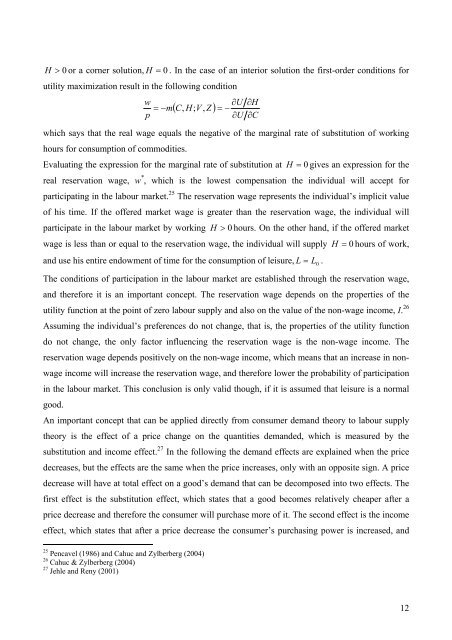An Analysis on Danish Micro Data - School of Economics and ...
An Analysis on Danish Micro Data - School of Economics and ...
An Analysis on Danish Micro Data - School of Economics and ...
Create successful ePaper yourself
Turn your PDF publications into a flip-book with our unique Google optimized e-Paper software.
H > 0 or a corner soluti<strong>on</strong>, H = 0 . In the case <strong>of</strong> an interior soluti<strong>on</strong> the first-order c<strong>on</strong>diti<strong>on</strong>s for<br />
utility maximizati<strong>on</strong> result in the following c<strong>on</strong>diti<strong>on</strong><br />
w<br />
= −m<br />
,<br />
p<br />
( C,<br />
H;<br />
V Z )<br />
∂U<br />
∂H<br />
= −<br />
∂U<br />
∂C<br />
which says that the real wage equals the negative <strong>of</strong> the marginal rate <strong>of</strong> substituti<strong>on</strong> <strong>of</strong> working<br />
hours for c<strong>on</strong>sumpti<strong>on</strong> <strong>of</strong> commodities.<br />
Evaluating the expressi<strong>on</strong> for the marginal rate <strong>of</strong> substituti<strong>on</strong> at H = 0 gives an expressi<strong>on</strong> for the<br />
real reservati<strong>on</strong> wage, w * , which is the lowest compensati<strong>on</strong> the individual will accept for<br />
participating in the labour market. 25 The reservati<strong>on</strong> wage represents the individual’s implicit value<br />
<strong>of</strong> his time. If the <strong>of</strong>fered market wage is greater than the reservati<strong>on</strong> wage, the individual will<br />
participate in the labour market by working H > 0 hours. On the other h<strong>and</strong>, if the <strong>of</strong>fered market<br />
wage is less than or equal to the reservati<strong>on</strong> wage, the individual will supply H = 0 hours <strong>of</strong> work,<br />
<strong>and</strong> use his entire endowment <strong>of</strong> time for the c<strong>on</strong>sumpti<strong>on</strong> <strong>of</strong> leisure, L = L0<br />
.<br />
The c<strong>on</strong>diti<strong>on</strong>s <strong>of</strong> participati<strong>on</strong> in the labour market are established through the reservati<strong>on</strong> wage,<br />
<strong>and</strong> therefore it is an important c<strong>on</strong>cept. The reservati<strong>on</strong> wage depends <strong>on</strong> the properties <strong>of</strong> the<br />
utility functi<strong>on</strong> at the point <strong>of</strong> zero labour supply <strong>and</strong> also <strong>on</strong> the value <strong>of</strong> the n<strong>on</strong>-wage income, I. 26<br />
Assuming the individual’s preferences do not change, that is, the properties <strong>of</strong> the utility functi<strong>on</strong><br />
do not change, the <strong>on</strong>ly factor influencing the reservati<strong>on</strong> wage is the n<strong>on</strong>-wage income. The<br />
reservati<strong>on</strong> wage depends positively <strong>on</strong> the n<strong>on</strong>-wage income, which means that an increase in n<strong>on</strong>wage<br />
income will increase the reservati<strong>on</strong> wage, <strong>and</strong> therefore lower the probability <strong>of</strong> participati<strong>on</strong><br />
in the labour market. This c<strong>on</strong>clusi<strong>on</strong> is <strong>on</strong>ly valid though, if it is assumed that leisure is a normal<br />
good.<br />
<str<strong>on</strong>g>An</str<strong>on</strong>g> important c<strong>on</strong>cept that can be applied directly from c<strong>on</strong>sumer dem<strong>and</strong> theory to labour supply<br />
theory is the effect <strong>of</strong> a price change <strong>on</strong> the quantities dem<strong>and</strong>ed, which is measured by the<br />
substituti<strong>on</strong> <strong>and</strong> income effect. 27 In the following the dem<strong>and</strong> effects are explained when the price<br />
decreases, but the effects are the same when the price increases, <strong>on</strong>ly with an opposite sign. A price<br />
decrease will have at total effect <strong>on</strong> a good’s dem<strong>and</strong> that can be decomposed into two effects. The<br />
first effect is the substituti<strong>on</strong> effect, which states that a good becomes relatively cheaper after a<br />
price decrease <strong>and</strong> therefore the c<strong>on</strong>sumer will purchase more <strong>of</strong> it. The sec<strong>on</strong>d effect is the income<br />
effect, which states that after a price decrease the c<strong>on</strong>sumer’s purchasing power is increased, <strong>and</strong><br />
25 Pencavel (1986) <strong>and</strong> Cahuc <strong>and</strong> Zylberberg (2004)<br />
26 Cahuc & Zylberberg (2004)<br />
27 Jehle <strong>and</strong> Reny (2001)<br />
12
















